GLOBALIZATION
10.3
LEARNING OBJECTIVE
Discuss the notion of global cities and some of the problems associated with them.
Many of the globalizing forces we have already discussed in this book—the integration of international economies, the interaction of different peoples, and the reshaping of culture—are centered in urban life. In other words, cities are the places where one can see both the multitude of benefits that derive from globalization, as well as the numerous pitfalls that it can bring. In this way, all cities can be considered global: they are places being shaped by the new global forces.
GLOBAL CITIES: YESTERDAY, TODAY, AND TOMORROW
Global cities are defined as those cities that have become the control centers of the global economy—the sites of major decisions about the world’s commercial networks and financial markets. Rather than being just big cities, global cities house a concentration of multinational and transnational corporate headquarters, international financial services, media offices, and related economic and cultural services. According to sociologist Saskia Sassen, who coined the term “global city” in 1991, there were at that time only three such cities operating at this level: New York City, London, and Tokyo. These cities had become, in many ways, the headquarters for a global economy and form the top level of a hierarchical global system of cities.
global cities
Cities that are control centers of the global economy.
Yet, an argument could certainly be made that cities have been, for at least six thousand years, a globally relevant mode of human dwelling in the world. To be sure, there were not as many cities nor were they as large as today’s megacities, but—as we have seen—cities in the ancient world were certainly powerful places. As industrialization progressed, cities became larger, more powerful centers of decision making, and through rural-to-urban migration affected the lives of greater numbers of people.
European colonialism from roughly the sixteenth through nineteenth centuries, and later manifestations of imperialism, can be understood as primarily an urban-based endeavor. In other words, the conquest of territories and economies was an enterprise driven largely through cities. Colonial cities were established throughout Latin America and the Caribbean, Asia, and Africa by colonizing European powers, particularly Spain, Portugal, England, France, Germany, Belgium, but also Japan. It was through these colonial urban centers that the subjugated territories and their inhabitants were governed, colonial economies and political systems were shaped, and the language and cultural patterns of the conquering power were imposed (Figure 10.22).
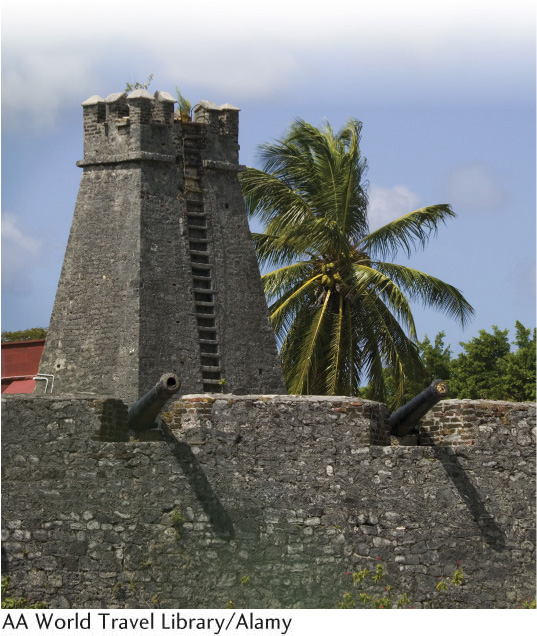
Contemporary definitions of a global city focus on the possession of certain characteristics. Among them are economic might, political power, information exchange, and research and development activity, as well as less tangible qualities such as influence, engagement, the ability to attract talented individuals, diversity, cultural experience, accessibility, and environmental quality. Being labeled a global city is desirable, and therefore many urban officials lobby to make the list of top global cities and—unsurprisingly—the number of lists has proliferated. Yet, the same 20 or so cities appear on most of the lists, though their exact place on a certain list may vary (Figure 10.23).

434
Urban geographers have broadened the analysis of global cities in order to also understand the next tier of cities within the urban hierarchy—those that contain a large percentage of producer service firms (law, accounting, advertising, financial services, consulting) that are international. In this framework, cities are categorized by the number and type of transnational firms they house—not only headquarters but also regional and national offices. This analysis has identified globally and regionally dominant cities and those that are major participants in the new global economy. Geographers Yefang Huang, Yee Leung, and Jianfa Shen refer to these as international cities—places that are significant because they are centers of the new international economy. Their analysis allowed them to identify degrees of internationalization based on the number and locations of the international firms each city contained. The result is a very interesting list organized into classes of international cities, dominated by six in class A (London, New York, Hong Kong, Tokyo, Singapore, and Paris), followed by 10 in class B and 44 in class C. In this way, we can begin to understand globalization as a multidimensional process that has impacts on many cities previously left unexamined.
435
THE GLOBALIZATION OF URBAN WEALTH AND POVERTY
Whatever the precise parameters used to rank them, it is the interconnected and powerful nature of global cities that makes them stand out from all other urban centers. And with the rise of the global city comes the rise of the global cosmopolitan class, consisting of those individuals who, in the words of geographers Sam Schueth and John O’Loughlin, “belong to the world.” Rather than being especially identified with one country, the global cosmopolitan moves with ease from place to place.
Ease of movement is usually only possible when one possesses wealth, and global cities are home to a great deal of wealthy individuals. Indeed, the presence of significant numbers of high net worth individuals is one criterion for inclusion as a global city, because this indicates a spatial concentration of economic power (Figure 10.24). And, though New York City tops the list when it comes to concentration of high net worth individuals, the super-wealthy—those with over $30 million in net assets—may be found nearly worldwide.
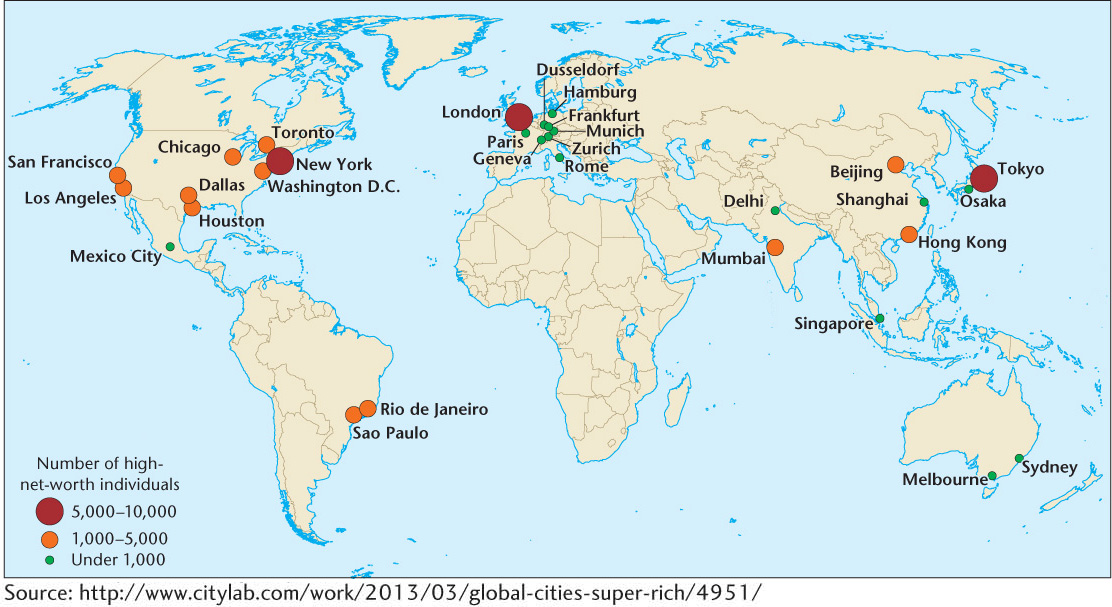
436
The tastes and needs of the global cosmopolitan class have shaped the global city in particular ways. One of these is the prevalence of highly securitized residential enclaves known as gated communities. Cities throughout the world are home to residential enclaves that are more or less privately governed: they have their own services such as security and landscaping, their own oversight board that sets and enforces policies, and their own amenities such as clubhouses, golf courses, and swimming pools. Some communities have walls or fences around them, use surveillance technology to track entry and exit, and restrict access through gates to those who live there or have been approved for temporary entry, such as the guests of residents. Others do not have obvious barriers setting them apart from the surrounding urban areas. Regardless, according to geographer Renaud Le Goix and urban planner Chris Webster, “The issue is not really the gate as such, it is the fragmentation of the urban governance realm into micro-territories.”
gated communities
Highly securitized residential enclaves that are more or less self-governing.
Approximately 15 percent of the housing stock in the United States is privately governed. And while it may be tempting to assume the gated community is a U.S. export, the researchers note it is an urban form that has arisen independently in cities for diverse reasons (Figure 10.25). Most of the reasons, however, can be traced to rising income inequality and fear. The wealthy in global cities have responded to this situation by attempting to shut out the have-nots, both from their residential spaces and from their urban governance processes. In some ways then, the urban wealthy have opted out of the global city.
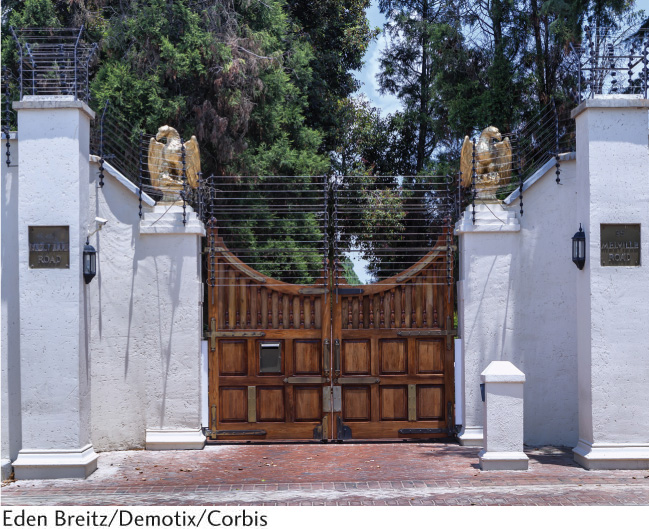
GLOBALIZATION OF URBAN POVERTY
Scholars of urban poverty have traditionally focused on the specific ways that poverty is manifest in urban environments in developing regions. But, recent economic hardship in Europe and North America has affected cities in these regions in many ways. Unemployment, deterioration of housing and urban infrastructure, homelessness, and other manifestations of poverty in the urban landscape are quite visible (Figure 10.26). You have encountered many examples thus far in this textbook of how urban poverty can be a problem in wealthy places as well as poor ones (see, for instance, Figure 3.35 and Figure 3.36 in Chapter 3 and Figure 9.21 and Figure 9.24 in Chapter 9). So, as with the rise of global cities and the global cosmopolitan class discussed above, it is important to bear in mind that urban poverty is not limited to the developing world but is rather a global phenomenon. Most global cities have pockets of both extreme wealth as well as its opposite, extreme poverty.
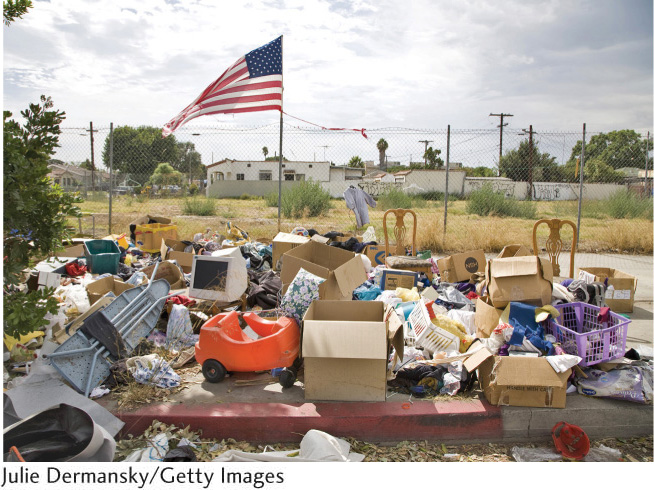
However, in cities of the developing world, the combination of large numbers of migrants and widespread unemployment leads to overwhelming pressure for low-rent housing in ways not frequently seen in cities in wealthier regions. Governments have rarely been able to meet these needs through housing projects, so one of the most characteristic landscape features of cities in the developing world has been the spontaneous construction of impoverished housing in areas known as shantytowns.
shantytowns
Precarious and often illegal housing settlements, usually made up of temporary shelters and located on the outskirts of a large city.
437
Shantytowns, also called favelas, barriadas, or squatter settlements, are often simply referred to as slums—areas of degraded, precarious, inadequate, and often illegal housing (see also Chapter 3). The United Nations defines a slum household as a cohabiting group that lacks one or more of the following conditions: an adequate physical structure that protects people from extreme climatic conditions, sufficient living area such that no more than three people share a room, access to a sufficient amount of water, access to sanitation, and secure habitation or protection from forced eviction. Over 1 billion people in the world live in slums: that is one out of every seven people on Earth. In greater Manila alone, for instance, scholars estimate that almost half of the city’s 19 million inhabitants live in slum conditions within shantytowns.
In his book Planet of Slums, urban theorist Mike Davis speculates that the proportion of humanity living in slums will incline sharply in the next few decades, to 2 billion or more, constituting a potentially volatile political group. Yet historically, shantytowns simply constitute the margin of urban growth in developing world cities. Because governments do not or will not expend the resources to build housing for the poor, the poor are forced to undertake this task themselves. Shantytowns usually begin as collections of crude shacks constructed from scrap materials; gradually, they become increasingly elaborate and permanent. Paths and walkways link houses, vegetable gardens spring up, and often water and electricity are bootlegged into the area so that a common tap or outlet serves a number of houses. At later stages, municipal governments install paved roads, electricity, and sewage systems and typically initiate some process—usually timed with the municipal elections cycle—to grant residents legal occupancy to shantytown lands. Thus, the city proper eventually takes most shantytowns under its wing, and in many instances these supposedly temporary settlements become permanent parts of the city, functioning as regularized and recognized urban neighborhoods. Some former slums in Mexico City, for example, have become so established that they are now attracting the wealthy and undergoing a process of gentrification.
Given their similarities across the globe, it is fair to ask whether global cities are converging in terms of how they look and “feel” to their residents (Figure 10.27). Is there, in other words, an emerging global city model? How much does it really matter if you are part of the global cosmopolitan class in Melbourne or Mumbai? Or, poor in Shanghai or São Paulo? This question is far too complex and subjective to be addressed appropriately here, but it is certainly worth considering.
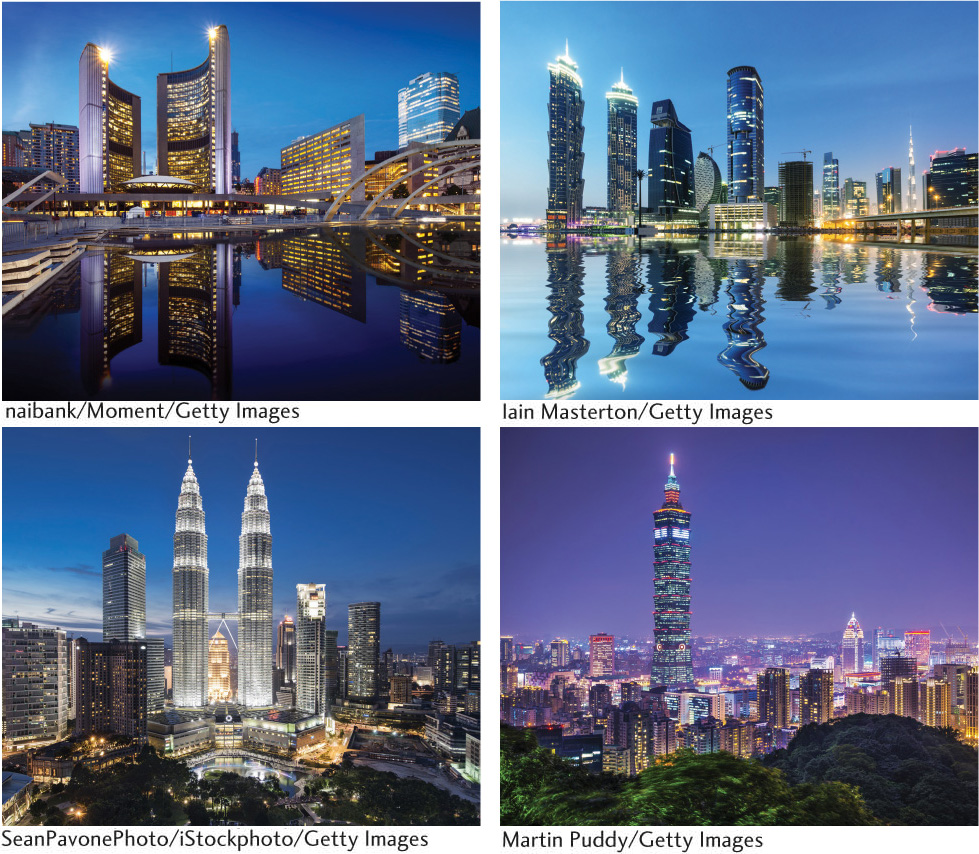
438